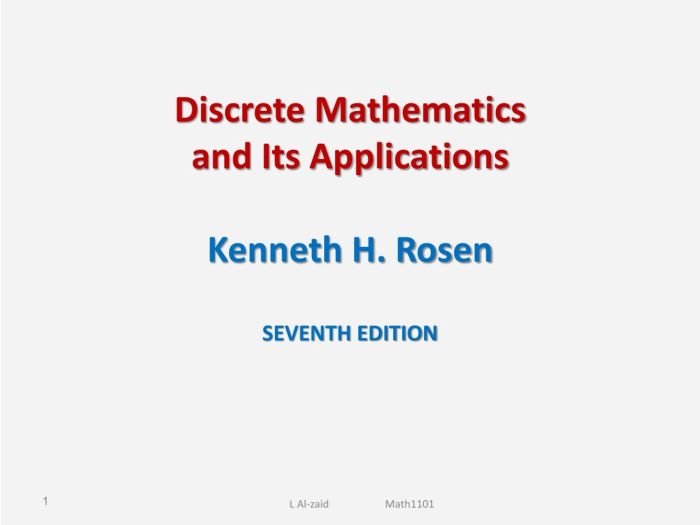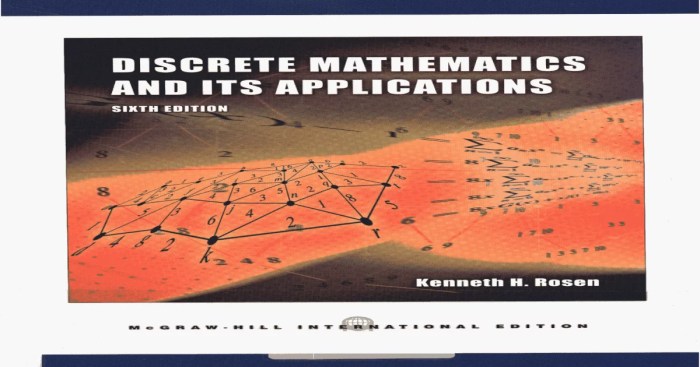Kenneth h rosen discrete mathematics and its applications seventh edition – Kenneth H. Rosen’s Discrete Mathematics and Its Applications, Seventh Edition, embarks on an enlightening journey into the realm of discrete mathematics, unveiling its fundamental principles and showcasing its pervasive applications across a multitude of disciplines. This comprehensive textbook provides an accessible and engaging exploration of the subject, empowering readers to delve into the intricacies of discrete mathematics and harness its power to solve real-world problems.
With its rigorous approach, meticulous organization, and abundance of illustrative examples, Rosen’s textbook stands as an indispensable resource for students, researchers, and practitioners alike. Its comprehensive coverage of core topics, coupled with its emphasis on mathematical tools and techniques, ensures a thorough understanding of the subject matter.
Furthermore, the textbook’s exploration of applications in computer science, operations research, biology, and social sciences underscores the versatility and far-reaching impact of discrete mathematics.
1. Overview of Discrete Mathematics and Its Applications
Discrete mathematics is a branch of mathematics that deals with objects that can be counted or separated into distinct units. It has a wide range of applications in various fields, including computer science, operations research, biology, and social sciences.
Discrete mathematics provides the foundation for understanding and solving problems involving finite sets, relations, functions, graphs, and algorithms. It is used to model and analyze real-world phenomena, such as the spread of diseases, the flow of traffic, and the design of computer networks.
Applications of Discrete Mathematics, Kenneth h rosen discrete mathematics and its applications seventh edition
- Computer science: data structures, algorithms, cryptography
- Operations research: optimization, scheduling, queuing theory
- Biology: population genetics, bioinformatics
- Social sciences: social networks, voting systems
2. Key Features of Kenneth H. Rosen’s Textbook: Kenneth H Rosen Discrete Mathematics And Its Applications Seventh Edition

Kenneth H. Rosen’s textbook, Discrete Mathematics and Its Applications, is a comprehensive and widely-used resource for students and practitioners of discrete mathematics. It is known for its clear and concise writing style,豊富なexamples, and challenging exercises.
The seventh edition of the textbook features several key improvements, including:
- Updated content to reflect the latest developments in discrete mathematics
- New and revised examples and exercises
- Improved pedagogical features, such as chapter summaries and study guides
Rosen’s textbook is a valuable resource for anyone interested in learning about discrete mathematics and its applications.
3. Coverage of Core Topics
The seventh edition of Rosen’s textbook covers a wide range of topics in discrete mathematics, including:
| Chapter | Topics |
|---|---|
| 1 | Sets, Relations, and Functions |
| 2 | Boolean Algebra |
| 3 | Graphs and Trees |
| 4 | Counting and Probability |
| 5 | Mathematical Induction and Recursion |
| 6 | Discrete Probability |
| 7 | Linear Programming |
| 8 | Number Theory |
4. Mathematical Tools and Techniques

Rosen’s textbook introduces a variety of mathematical tools and techniques that are essential for solving problems in discrete mathematics. These tools include:
- Proof techniques: induction, contradiction, contrapositive
- Combinatorics: counting techniques, generating functions
- Graph theory: algorithms for finding shortest paths, spanning trees
- Number theory: primality testing, modular arithmetic
These tools are used to solve a wide range of problems, from finding the shortest path in a network to determining the number of ways to choose a committee from a group of people.
5. Applications in Computer Science
Discrete mathematics is a fundamental tool for computer scientists. It is used in the design and analysis of algorithms, data structures, and cryptography.
- Algorithms: Discrete mathematics is used to analyze the efficiency and correctness of algorithms. For example, it is used to determine the time and space complexity of an algorithm.
- Data structures: Discrete mathematics is used to design and analyze data structures, such as stacks, queues, and trees. For example, it is used to determine the average and worst-case performance of a data structure.
- Cryptography: Discrete mathematics is used to design and analyze cryptographic algorithms, such as encryption and decryption algorithms. For example, it is used to design algorithms that are resistant to attack.
6. Applications in Other Fields
Discrete mathematics is also used in a variety of other fields, including operations research, biology, and social sciences.
- Operations research: Discrete mathematics is used to solve optimization problems, such as scheduling problems and routing problems. For example, it is used to design algorithms that find the shortest path between two points or the most efficient way to schedule a set of tasks.
- Biology: Discrete mathematics is used to model and analyze biological systems, such as population genetics and bioinformatics. For example, it is used to design algorithms that can predict the evolution of a population or identify patterns in DNA sequences.
- Social sciences: Discrete mathematics is used to model and analyze social systems, such as social networks and voting systems. For example, it is used to design algorithms that can identify influential individuals in a social network or predict the outcome of an election.
7. Pedagogical Features and Learning Resources
Rosen’s textbook includes a variety of pedagogical features to help students learn discrete mathematics. These features include:
- Examples: Each chapter contains numerous examples that illustrate the concepts and techniques being discussed.
- Exercises: Each chapter contains a large number of exercises, ranging from basic to challenging. These exercises help students to practice the concepts and techniques they have learned.
- Chapter summaries: Each chapter concludes with a summary of the key concepts and techniques covered in the chapter.
- Study guides: Each chapter includes a study guide that helps students to review the material and prepare for exams.
In addition to the textbook, there are a number of online learning resources available to support students using the textbook. These resources include:
- Website: The textbook’s website contains a variety of resources, including practice exercises, solutions to selected exercises, and links to other online resources.
- Online homework system: The textbook’s online homework system allows students to practice the concepts and techniques they have learned in the textbook.
8. Critical Analysis and Evaluation

Rosen’s textbook is a well-written and comprehensive resource for students and practitioners of discrete mathematics. It is clear and concise, and it provides a wealth of examples and exercises.
One of the strengths of the textbook is its focus on applications. Rosen shows how discrete mathematics can be used to solve problems in a variety of fields, including computer science, operations research, biology, and social sciences.
However, the textbook is not without its weaknesses. One criticism is that it is too theoretical. Some students may find it difficult to understand the concepts and techniques being discussed without more concrete examples.
Another criticism is that the textbook is too long. It is over 1,000 pages long, and it can be difficult for students to keep up with the material.
Overall, Rosen’s textbook is a valuable resource for students and practitioners of discrete mathematics. It is clear and concise, and it provides a wealth of examples and exercises. However, students should be aware of the textbook’s weaknesses before they decide to use it.
FAQ Resource
What are the key features of Kenneth H. Rosen’s Discrete Mathematics and Its Applications, Seventh Edition?
Rosen’s textbook is renowned for its comprehensive coverage of core topics, its emphasis on mathematical tools and techniques, its abundance of illustrative examples, and its exploration of applications across a wide range of disciplines.
How is Rosen’s textbook organized?
The textbook is meticulously organized into eight chapters, each covering a specific aspect of discrete mathematics. The chapters are further divided into sections, providing a logical and coherent structure for learning.
What are the pedagogical features of Rosen’s textbook?
Rosen’s textbook incorporates a wealth of pedagogical features, including illustrative examples, practice exercises, chapter summaries, and online learning resources. These features enhance student learning and reinforce understanding of the subject matter.